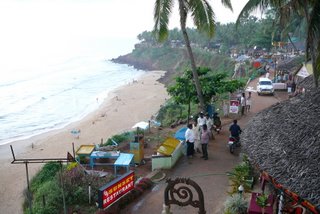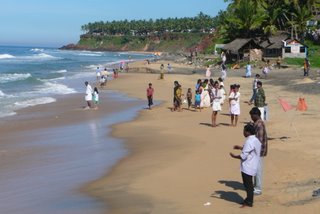 Varkala Town is a typical small market town in South India. With a population that I estimate to be around 10 000, it has a train station, a bus terminal and a constant buzz of traffic along its tangle of streets. The town centre covers a few blocks with stalls selling the usual assortment of vegetables, pots and dishes, plastic buckets, shoes, and clothes. Away from the centre radiate three main roads (one leads to the beach) along which are schools, a hospital, a multitude of shops, offices and eventually houses. We have to go to town
Varkala Town is a typical small market town in South India. With a population that I estimate to be around 10 000, it has a train station, a bus terminal and a constant buzz of traffic along its tangle of streets. The town centre covers a few blocks with stalls selling the usual assortment of vegetables, pots and dishes, plastic buckets, shoes, and clothes. Away from the centre radiate three main roads (one leads to the beach) along which are schools, a hospital, a multitude of shops, offices and eventually houses. We have to go to town  for anything more than the milk, eggs, oranges and biscuits that our corner shop sells and for specialized services such as enquiring about an Internet connection or to use a bank machine. Town seems to be reasonably prosperous (so far I have encountered only two beggars) and most of the locals appear to be working and middle class Keralans. On a typical visit to town we might see a few other westerners.
for anything more than the milk, eggs, oranges and biscuits that our corner shop sells and for specialized services such as enquiring about an Internet connection or to use a bank machine. Town seems to be reasonably prosperous (so far I have encountered only two beggars) and most of the locals appear to be working and middle class Keralans. On a typical visit to town we might see a few other westerners.Varkala Cliff is about 2 km from town. The cliff district is a series of restaurants, guesthouses and shops that have sprung up in the past few years to cater to western travellers. As the name implies it is a strip that winds about half a kilometre along the top of a cliff overlooking a picturesque swimming beach, aptly named Cliff Beach. The Cliff district is quite charming and calm, especially the portion that is inaccessible by car. Many of the buildings are still made of palm fronds, but these are being replaced by newer brick and concrete structures. The atmosphere is reminiscent of the Thamel area in Kathmandu from the 1980s, even down to the touts encouraging passers to go into the Kashmiri and Tibetan shops. Now that we have been
 here for more than a week, many of the shopkeepers recognize us so a stroll down the cliff is a constant interaction: “Hello, nice family” and of course “Hello Madame, come look my shop”, “You want dinner? Very fresh fish”, “Elephant ride” and so on. The western population can be sorted into two main groups: At the Sun Set Restaurant, listening to reggae, smoking and drinking coffees, the patrons seem unchanged from the people I met on the beaches of India 20 years ago: tanned and sparsely dressed in locally made clothing, they have been in Asia for months and Varkala is just one stop. The tourists staying at the Green Resort appear to be the product of the now easier travel to India and their fresh sunburns and western clothes indicate they have just arrived or have come for a two week vacation in the sun, like the woman from Manchester we spoke to last night. The cliff beach is where the westerners swim. It has great waves for body-surfing, medium fine sand, lifeguards and umbrellas for rent. Our house is a five-minute walk to the cliff and we most often swim at the cliff beach, so we are there at least once a day.
here for more than a week, many of the shopkeepers recognize us so a stroll down the cliff is a constant interaction: “Hello, nice family” and of course “Hello Madame, come look my shop”, “You want dinner? Very fresh fish”, “Elephant ride” and so on. The western population can be sorted into two main groups: At the Sun Set Restaurant, listening to reggae, smoking and drinking coffees, the patrons seem unchanged from the people I met on the beaches of India 20 years ago: tanned and sparsely dressed in locally made clothing, they have been in Asia for months and Varkala is just one stop. The tourists staying at the Green Resort appear to be the product of the now easier travel to India and their fresh sunburns and western clothes indicate they have just arrived or have come for a two week vacation in the sun, like the woman from Manchester we spoke to last night. The cliff beach is where the westerners swim. It has great waves for body-surfing, medium fine sand, lifeguards and umbrellas for rent. Our house is a five-minute walk to the cliff and we most often swim at the cliff beach, so we are there at least once a day.The true Varkala Beach is about a half a kilometre along the coast from the cliff and it has been a resort attraction for Indians long before it was “discovered” by the Lonely Planet Guidebook and western travellers. An important Hindu temple that is said to be more than one thousand years old attracts pilgrims from far away and the healing waters and Aryuvedic treatment centres have spawned numerous “resort hotels” ranging from the very simple to the opulent Taj Garden, which at over CDN $100 per night, caters to the wealthy from all over India. The people at Varkala Beach are completely different from the bikini wearing sunbathers at the
 cliff. Last Sunday morning we went to Varkala Beach in time for puja. Sitting in the shade of makeshift palm frond walls, a row of Brahmin priests were selling flowers on a banana leaf to be used as offerings, or puja. Indian families dressed in their Sunday best lined up to buy a puja and have it blessed, and then proceed with the little pile to the waters edge, toss it into the waves and say or chant some prayers. No-one was getting wet. Even at non-puja times, most Indians go to the beach only to walk on the sand. The more adventurous will wade up to their knees in the surf, the women fully clothed in saris and the prosperous men in shirts and trousers, only a few athletic men will actually swim. A woman I spoke to said that most Indians do not know how to swim, but that is changing as now all children in Kerala schools are given instruction in swimming.
cliff. Last Sunday morning we went to Varkala Beach in time for puja. Sitting in the shade of makeshift palm frond walls, a row of Brahmin priests were selling flowers on a banana leaf to be used as offerings, or puja. Indian families dressed in their Sunday best lined up to buy a puja and have it blessed, and then proceed with the little pile to the waters edge, toss it into the waves and say or chant some prayers. No-one was getting wet. Even at non-puja times, most Indians go to the beach only to walk on the sand. The more adventurous will wade up to their knees in the surf, the women fully clothed in saris and the prosperous men in shirts and trousers, only a few athletic men will actually swim. A woman I spoke to said that most Indians do not know how to swim, but that is changing as now all children in Kerala schools are given instruction in swimming.
No comments:
Post a Comment